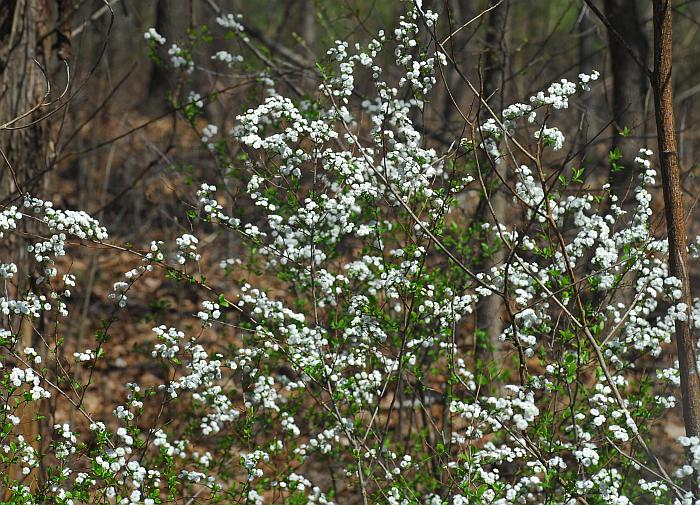Spiraea prunifolia Siebold & Zucc.
Bridal Wreath

Introduced
CC = *
CW = 5
MOC = 14
© SRTurner
Spiraea prunifolia Siebold & Zucc.Bridal Wreath | |
 |
Introduced CC = * CW = 5 MOC = 14 |
© SRTurner |
|
Family - Rosaceae Habit - Shrubs, to 1.5 m tall, but the stems often longer and strongly arching. Stems - Twigs reddish brown to dark grayish brown, somewhat angular, moderately to densely and minutely hairy, at least when young, often also with scattered, longer, more or less spreading hairs.
Leaves - Alternate, simple, short-petiolate. Leaf blades 1-4 cm long, elliptic to ovate, angled to short-tapered at the base, rounded or angled to a bluntly pointed tip, the margins finely and sharply toothed, the upper surface glabrous or sparsely hairy along the main veins, sometimes somewhat shiny, the undersurface sparsely to moderately hairy.
Inflorescences - axillary, umbellate clusters of 2-6 flowers.
Flowers - Hypanthia 1.5-2.0 mm wide, cup-shaped to somewhat conic, glabrous or sparsely hairy. Sepals 5, 0.8-1.2 mm long, triangular to broadly triangular, sharply pointed at the tip. Corollas appearing doubled, with numerous petals. Petals 2.0-2.5 mm long, white. Ovaries glabrous.
Fruits - Infrequently produced, 1.5-2.5 mm long, glabrous. Flowering - April - May. Habitat - Cultivated and persistent around old homesites, cemeteries, pastures, and fencerows, occasionally escaping. Origin - Native to eastern Asia. Other info. - This striking species is found in a few scattered counties in Missouri, predominantly in the eastern parts of the state. It likewise occurs in widely scattered locations throughout the eastern half of the continental U.S. It is uncommon in the wild, and its presence usually points to an old homesite or other instance of previous cultivation. It is easily recognized by its profusely flowering branches bearing umbellate clusters. The flowers usually have doubled petals and look a bit like miniature versions of cultivated white roses. This modification occurs at the expense of most of the flower's functional parts, and accordingly the plant reproduces mainly vegetatively, by root sprouts. The multiple thin stems arch with age. Photographs taken in Umstead State Park, Raleigh, NC., 3-23-03 (DETenaglia); also at Weldon Spring Conservation Area, St. Charles County, MO, 4-6-2011, and at Little Lost Creek Conservation Area, Warren County, MO, 3-26-2016 and 4-8-2020 (SRTurner). |